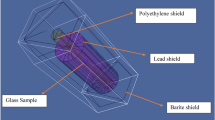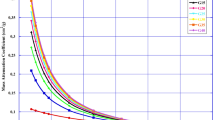Abstract
For Pb-free 35B2O3‒35Bi2O3‒(30–x)TeO2‒(x)BaO (x = 5, 10, 15, 20, and 25 mol%) and (90–x)TeO2‒10Bi2O3‒(x)BaO (x = 10, 15, and 20 mol%) glass systems, gamma and neutron (both fast and thermal neutron) radiation shielding features were examined and compared. Within 0.015–15 MeV photon energy, mass attenuation coefficients (μ/ρ), for all samples, which have been assessed using WinXCOM program are in fair agreement with deduced MCNP5 simulation code μ/ρ results. For all selected samples, at the lowest energy, μ/ρ has bigger values whereas at higher energy regions possess lower values. Furthermore, by employing μ/ρ values, effective atomic number (Zeff), effective electron density (Neff), half-value layer (HVL), tenth-value layer (TVL), and mean free path (MFP) are figured out for both glass systems. For studied samples, with the gradual replacement of TeO2 content with BaO, the derived values of Zeff, HVL, TVL, and MFP revealed improved γ-ray shielding potentiality. Besides, within photon energy range of 0.015–15 MeV, exposure build-up factors (EBFs) and energy absorption build-up factors (EABFs) were estimated for all samples by utilizing G‒P fitting method as a function of different penetration depths (0.5, 1, 2, 3, 4, 5, 6, 7, 8, 10, 15, 20, 25, 30, 35, and 40 mfp). The 35B2O3–35Bi2O3–5TeO2–25BaO (mol%) glass relatively larger μ/ρ and Zeff values, lower HVL, TVL, and MFP values, and minimal EBF and EABF values confirm its superior γ-ray attenuation competence among all samples. Additionally, in comparison, HVL and MFP values of 35B2O3–35Bi2O3–5TeO2–25BaO (mol%) sample are lower than the respective values of some commercial γ-ray shielding glasses and different types of standard concretes, signifying its better shielding features than them. Moreover, macroscopic removal cross-section for fast neutrons (ΣR), coherent scattering cross-section (σcs), incoherent scattering cross-section (σics), absorption cross-section (σA), and total cross-section (σT) for thermal neutrons absorption were derived for both glass systems. Among all selected glasses, 35B2O3–35Bi2O3–5TeO2–25BaO (mol%) sample possesses relatively higher ΣR (0.106 cm−1) and ‘σT’ (8.809 cm−1 at 0.0253 eV neutron energy) values for fast and thermal neutrons attenuation, respectively, demonstrating its favorable absorption capability for neutrons.











Similar content being viewed by others
References
https://www.nuclear-power.net/nuclear-power/reactor-physics/atomic-nuclear-physics/radiation/shielding-of-ionizing-radiation/. Accessed Jan 2020
C. Grupen, M. Rodgers, What are Radioactivity and Radiation? in Radioactivity and Radiation (Springer, Cham, 2016) pp. 7–25. https://doi.org/10.1007/978-3-319-42330-2_2
H. Domenech, Shielding, in Radiation Safety (Springer, Cham, 2017) pp. 97–109. https://doi.org/10.1007/978-3-319-42671-6_7
S. Mattsson, C. Hoeschen, The importance of radiation protection in nuclear medicine, in Radiation Protection in Nuclear Medicine, ed. by S. Mattsson, C. Hoeschen, 1st edn. (Malmo: Springer-Verlag, Berlin Heidelberg, 2013). https://doi.org/10.1007/978-3-642-31167-3
R. Parvaresh, A. Haghparast, K. Khoshgard, M. Jalili, M.T. Eivazi, M. Ghorbani, An investigation to determine an optimum protective garment material in nuclear medicine. J Biomed. Phys. Eng. 8(4), 381–392 (2018)
B. Serencsits, B.M. Quinn, L.T. Dauer, An Introduction to Radiation Protection, in Radiopharmaceutical Chemistry, ed. by J. Lewis, A. Windhorst, B. Zeglis (Cham, Springer, 2019), pp. 515–529. https://doi.org/10.1007/978-3-319-98947-1_29
C.-M. Lee, Y.H. Lee, K.J. Lee, Cracking effect on gamma-ray shielding performance in concrete structure. Prog. Nucl. Energy 49, 303–312 (2007)
M. Boskabady, N. Marefati, T. Farkhondeh, F. Shakeri, A. Farshbaf, M.H. Boskabady, The effect of environmental lead exposure on human health and the contribution of inflammatory mechanisms, a review. Environ. Int. 120, 404–420 (2018)
J. Kaewkhao, Development of lead free radiation shielding glass: Experimental and theoretical approach, 2nd International Conference on Instrumentation, Communication, Information Technology and Biomedical Engineering (ICICI-BME), 2011. P. 1‒7. 8‒9 November 2011, Bandung, Indonesia. https://doi.org/10.1109/ICICI-BME.2011.6108579
Y. Al-Hadeethi, S.A. Tijani, The use of lead-free transparent 50BaO-(50–x)borosilicate-xBi2O3 glass system as radiation shields in nuclear medicine. J. Alloys Compd. 803, 625–630 (2019)
M.V. Rao, V.V.R.K. Kumar, Nk Shihab, D.N. Rao, Z-scan studies of barium bismuth borate glasses. Opt. Mater. 84, 178–183 (2018)
G. Lakshminarayana, S.O. Baki, A. Lira, I.V. Kityk, U. Caldiño, K.M. Kaky, M.A. Mahdi, Structural, thermal and optical investigations of Dy3+-doped B2O3–WO3–ZnO–Li2O–Na2O glasses for warm white light emitting applications. J. Lumin. 186, 283–300 (2017)
G. Lakshminarayana, K.M. Kaky, S.O. Baki, S. Ye, A. Lira, I.V. Kityk, M.A. Mahdi, Concentration dependent structural, thermal, and optical features of Pr3+-doped multicomponent tellurite glasses. J. Alloys Compd. 686, 769–784 (2016)
H.O. Tekin, O. Kilicoglu, The influence of gallium (Ga) additive on nuclear radiation shielding effectiveness of Pd/Mn binary alloys. J. Alloys Compd. 815, 152484 (2020)
T. Bel, C. Arslan, N. Baydogan, Radiation shielding properties of poly (methyl methacrylate)/colemanite composite for the use in mixed irradiation fields of neutrons and gamma rays. Mater. Chem. Phys. 221, 58–67 (2019)
M.A. Masoud, W.A. Kansouh, M.G. Shahien, K. Sakr, A.M. Rashad, A.M. Zayed, An experimental investigation on the effects of barite/hematite on the radiation shielding properties of serpentine concretes. Prog. Nucl. Energy 120, 103220 (2020)
G. Lakshminarayana, M.G. Dong, A. Kumar, Y. Elmahroug, A. Wagh, D.-E. Lee, J. Yoon, T. Park, Assessment of gamma-rays and fast neutron beam attenuation features of Er2O3-doped B2O3–ZnO–Bi2O3 glasses using XCOM and simulation codes (MCNP5 and Geant4). Appl. Phys. A 125, 1–14 (2019)
B. Aygün, High alloyed new stainless steel shielding material for gamma and fast neutron radiation. Nucl. Eng. Technol. (2019). https://doi.org/10.1016/j.net.2019.08.017
F. Akman, Z.Y. Khattari, M.R. Kaçal, M.I. Sayyed, F. Afaneh, The radiation shielding features for some silicide, boride and oxide types ceramics. Radiat. Phys. Chem. 160, 9–14 (2019)
X. Li, J. Wu, C. Tang, Z. He, P. Yuan, Y. Sun, W.-M. Lau, K. Zhang, J. Mei, Y. Huang, High temperature resistant polyimide/boron carbide composites for neutron radiation shielding. Compos. Part B Eng. 159, 355–361 (2019)
M.S. Al-Buriahi, A.S. Abouhaswa, H.O. Tekin, C. Sriwunkum, F.I. El-Agawany, T. Nutaro, E. Kavaz, Y.S. Rammah, Structure, optical, gamma-ray and neutron shielding properties of NiO doped B2O3–BaCO3–Li2O3 glass systems. Ceram. Int. 46, 1711–1721 (2020)
M.I. Sayyed, A. Kumar, H.O. Tekin, R. Kaur, M. Singh, O. Agar, M.U. Khandaker, Evaluation of gamma-ray and neutron shielding features of heavy metals doped Bi2O3–BaO–Na2O–MgO–B2O3 glass systems. Prog. Nucl. Energy 118, 103118 (2020)
Y. Al-Hadeethi, M.I. Sayyed, H. Mohammed, L. Rimondini, X-ray photons attenuation characteristics for two tellurite based glass systems at dental diagnostic energies. Ceram. Int. 46, 251–257 (2020)
Y. Al-Hadeethi, M.I. Sayyed, Analysis of borosilicate glasses doped with heavy metal oxides for gamma radiation shielding application using Geant4 simulation code. Ceram. Int. 45, 24858–24864 (2019)
E. Kavaz, An experimental study on gamma ray shielding features of lithium borate glasses doped with dolomite, hematite and goethite minerals. Radiat. Phys. Chem. 160, 112–123 (2019)
A. Sharma, M.I. Sayyed, O. Agar, H.O. Tekin, Simulation of shielding parameters for TeO2–WO3–GeO2 glasses using FLUKA code. Results Phys. 13, 102199 (2019)
R.S. Kaundal, Comparative study of radiation shielding parameters for bismuth borate glasses. Mater. Res. 19, 776–780 (2016)
P. Kaur, K.J. Singh, S. Thakur, Evaluation of the gamma radiation shielding parameters of bismuth modified quaternary glass system. AIP Conf. Proc. 2018, 1–3 (1953). https://doi.org/10.1063/1.5032878
E. Salama, A. Maher, Application of GATE/GEANT 4 code in investigation of gamma shielding effectiveness of glass materials, IOP Conf. Series: Journal of Physics: Conf. Series (2019). https://doi.org/10.1088/1742-6596/1253/1/012032.
H.O. Tekin, O. Kilicoglu, E. Kavaz, E.E. Altunsoy, M. Almatari, O. Agar, M.I. Sayyed, The investigation of gamma-ray and neutron shielding parameters of Na2O–CaO–P2O5–SiO2 bioactive glasses using MCNPX code. Results Phys. 12, 1797–1804 (2019)
B. Srinivas, A. Hameed, M. N. Chary, Md. Shareefuddin, Physical, optical and FT-IR studies of Bismuth-Boro-tellurite glasses containing BaO as modifier, IOP Conf. Series: Mater. Sci. Eng. 360 (2018) 012022/1‒6
J. Jackson, C. Smith, J. Massera, C.R. Baleine, C. Bungay, L. Petit, K. Richardson, Estimation of peak Raman gain coefficients for Barium–Bismuth–Tellurite glasses from spontaneous Raman cross-section experiments. Opt. Express 17, 9071–9079 (2009)
L. Gerward, N. Guilbert, K.B. Jensen, H. Levring, WinXCom—a program for calculating X-ray attenuation coefficients. Radiat. Phys. Chem. 71, 653–654 (2004)
M.I. Sayyed, M.G. Dong, H.O. Tekin, G. Lakshminarayana, M.A. Mahdi, Comparative investigations of gamma and neutron radiation shielding parameters for different borate and tellurite glass systems using WinXCom program and MCNPX code. Mater. Chem. Phys. 215, 183–202 (2018)
G. Lakshminarayana, A. Kumar, M.G. Dong, M.I. Sayyed, N.V. Long, M.A. Mahdi, Exploration of gamma radiation shielding features for titanate bismuth borotellurite glasses using relevant software program and Monte Carlo simulation code. J. Non-Cryst. Solids 481, 65–73 (2018)
E. Kavaz, H.O. Tekin, N.Y. Yorgun, Ö.F. Özdemir, M.I. Sayyed, Structural and nuclear radiation shielding properties of bauxite ore doped lithium borate glasses: experimental and Monte Carlo study. Radiat. Phys. Chem. 162, 187–193 (2019)
A. Alatawi, A.M. Alsharari, S.A.M. Issa, M. Rashad, A.A.A. Darwish, Y.B. Saddeek, H.O. Tekin, Improvement of mechanical properties and radiation shielding performance of AlBiBO3 glasses using yttria: an experimental investigation. Ceram. Int. 46, 3534–3542 (2020)
ANSI/ANS-6.4.3 Gamma-Ray Attenuation Coefficient and Buildup Factors for Engineering Materials (American Nuclear Society, La Grange Park, Illinois, 1991).
C. Dees (Idaho National Laboratory), June 2017, Neutron Radiation Shielding Strategies for Glovebox Applications, American Glovebox Society Annual Conference.
https://www.nuclear-power.net/nuclear-power/reactor-physics/atomic-nuclear-physics/fundamental-particles/neutron/shielding-neutron-radiation/. Accessed Jan 2020
I.I. Bashter, Calculation of radiation attenuation coefficients for shielding concretes. Ann. Nucl. Energy 24, 1389–1401 (1997)
O. Kilicoglu, E.E. Altunsoy, O. Agar, M. Kamislioglu, M.I. Sayyed, H.O. Tekin, N. Tarhan, Synergistic effect of La2O3 on mass stopping power (MSP)/projected range (PR) and nuclear radiation shielding abilities of silicate glasses. Results Phys. 14, 102424 (2019)
S.A.M. Issa, H.O. Tekin, R. Elsaman, O. Kilicoglu, Y.B. Saddeek, M.I. Sayyed, Radiation shielding and mechanical properties of Al2O3–Na2O–B2O3–Bi2O3 glasses using MCNPX Monte Carlo code. Mater. Chem. Phys. 223, 209–219 (2019)
C. Jumpee, D. Wongsawaeng, Innovative neutron shielding materials composed of natural rubber-styrene butadiene rubber blends, boron oxide and iron(III) oxide. J. Phys. Conf. Ser. 611, 012019 (2015). https://doi.org/10.1088/1742-6596/611/1/012019
M.K.A. Roslan, M. Ismail, A.B.H. Kueh, M.R.M. Zin, High-density concrete: exploring Ferro boron effects in neutron and gamma radiation shielding. Constr. Build. Mater. 215, 718–725 (2019)
M.B. Chadwick, M. Herman, P. Obložinský et al., ENDF/B-VII1 Nuclear Data for Science and Technology: Cross Sections, Covariances, Fission Product Yields and Decay Data. Nucl. Data Sheets 112, 2887–2996 (2011). https://doi.org/10.1016/j.nds.2011.11.002
M.G. Dong, X.X. Xue, Z.F. Li, H. Yang, M.I. Sayyed, B.O. Elbashir, Preparation, shielding properties and mechanism of a novel neutron shielding material made from natural Szaibelyite resource. Prog. Nucl. Energy 106, 140–145 (2018)
Acknowledgements
This work was supported in part by the National Research Foundation of Korea (NRF) grant funded by the Korea government (MSIT) (No. NRF-2018R1A5A1025137), and in part by the Research Fund of Hanyang University (No. HY-2015-G).
Author information
Authors and Affiliations
Corresponding authors
Additional information
Publisher's Note
Springer Nature remains neutral with regard to jurisdictional claims in published maps and institutional affiliations.
Electronic supplementary material
Below is the link to the electronic supplementary material.
Rights and permissions
About this article
Cite this article
Lakshminarayana, G., Dong, M.G., Al-Buriahi, M.S. et al. B2O3–Bi2O3–TeO2–BaO and TeO2–Bi2O3–BaO glass systems: a comparative assessment of gamma-ray and fast and thermal neutron attenuation aspects. Appl. Phys. A 126, 202 (2020). https://doi.org/10.1007/s00339-020-3372-4
Received:
Accepted:
Published:
DOI: https://doi.org/10.1007/s00339-020-3372-4




